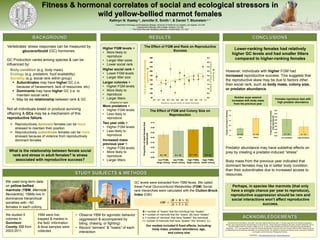
Marmot Social Stress and Reproduction
- 1. We thank all the marmoteers, since 2001, who have helped collect these data. D.T.B was supported by the National Geographic Society, UCLA (Faculty Senate and the Division of Life Sciences), a Rocky Mountain Biological Laboratory research fellowship, and by the NSF (IDBR-0754247 and DEB-1119660 to D.T.B., as well as DBI 0242960 and 0731346 to the Rocky Mountain Biological Laboratory). J.E.S. was supported by funds from Faculty Development Funds and from the Provost’s Office at Mills College as well as by fellowships from the American Association of University Women, the Institute for Society and Genetics at the University of California Los Angeles, and the American Philosophical Society. GRAPHICS: www.adamspestcontrol.com; www.ironphoenix.org a Department of Ecology and Evolutionary Biology, University of California Los Angeles, Los Angeles, CA USA b Department of Biology, Mills College, Oakland, CA,USA c The Rocky Mountain Biological Laboratory, Crested Butte, CO, USA Fitness & hormonal correlates of social and ecological stressors in wild yellow-bellied marmot females Vertebrates’ stress responses can be measured by glucocorticoid (GC) hormones. GC Production varies among species & can be influenced by: Reproductively dominant females can be more stressed to maintain their position Reproductively subordinate females can be more stressed because of violence from reproductively dominant females However, individuals with higher FGM had increased reproductive success. This suggests that the reproductive skew may be due to factors other than social rank, such as body mass, colony size, or predator abundance. Higher FGM levels = • More likely to reproduce • Larger litter sizes • Lower social rank Higher social rank = • Lower FGM levels • Larger litter size Larger colonies = • Higher FGM levels • More likely to • reproduce • Larger litters (Graphed on right) More predators = • Higher FGM levels • Less likely to reproduce Two year olds = • Higher FGM levels • Less likely to reproduce Increased mass previous year = • Higher FGM levels • More likely to reproduce • Larger litters Perhaps, in species like marmots (that only have a single chance per year to reproduce), reproductive suppression should be rare and social interactions won’t affect reproductive success. What is the relationship between female social rank and stress in adult females? Is stress associated with reproductive success? Kathryn N. Keeley a, Jennifer E. Smith b, & Daniel T. Blumstein a, c We used long-term data on yellow-bellied marmots (YBM; Marmota flaviventris). YBMs live in dominance hierarchical societies with ~50 females in each colony. 𝑪𝑩𝑰 = (𝑩 + 𝒃 + 𝟏) (𝑳 + 𝒍 + 𝟏) B = number of “losers” that the individual has “beaten” b = number of marmots that the “losers” (B) have “beaten” L = number of “winners” that have “beaten” the individual l = number of marmots that have “beaten” the “winners” (L) YBM were live- trapped & marked in the field. Information & fecal samples were collected. • Observe YBM for agonistic behavior (aggression & accompanied by biting, chasing, or fighting) • Record “winners” & “losers” of each interaction GC levels were extracted from YBM feces. We called these Fecal Glucocorticoid Metabolites (FGM) Social rank hierarchies were calculated with the Clutton-Brock Index (CBI): Our models included 9 fixed effects, including: body mass, predator abundance, age, and colony size Lower-ranking females had relatively higher GC levels and had smaller litters compared to higher-ranking females Predator abundance may have sublethal effects on prey by creating a predator-induced “stress” Body mass from the previous year indicated that dominant females may be in better body condition than their subordinates due to increased access to resources. Body condition (e.g. body mass) Ecology (e.g. predators, food availability) Sociality (e.g. social rank within group) Subordinates may have higher GC (i.e. because of harassment, lack of resources, etc) Dominants may have higher GC (i.e. to maintain social rank) May be no relationship between rank & GC Not all individuals breed or produce surviving offspring & GCs may be a mechanism of this reproductive failure. 0.0 0.5 1.0 1.5 2.0 2.5 3.0 3.5 4.0 4.5 80 100 120 140 160 180 200 220 240 260 -0.1 0.1 0.2 0.3 0.4 0.5 0.6 0.7 0.8 0.9 1.0 1.1 Fecalglucocorticoidmetabolites (ng/gfeces) Numberofpupssurvivingto weaning Relative social rank of adult females 0.00 0.10 0.20 0.30 0.40 0.50 0.60 0.70 low FCMs large colony low FCMs small colony high FGMs large colony high FGMs small colony Proportionofadultfemalesthat reproduced N = 68 N = 30 N = 116 N = 44 The Effect of FGM and Colony Size on Reproduction The Effect of FGM and Rank on Reproductive Success We studied 5 colonies in Gunnison County, CO from 2003-2011. 1.0 1.5 2.0 2.5 3.0 3.5 Low Heavy #pupssurvivingtoweaning 0.46 0.48 0.50 0.52 0.54 0.56 0.58 0.60 0.62 low predation high predation Proportionofadultfemales thatreproduced N = 122 N = 151 Number pups weaned increases with body mass from the previous year Females reproduce less with high predator abundance N = 139 N = 134
